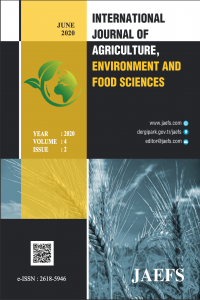Araştırma Makalesi
Yıl 2020,
Cilt: 4 Sayı: 2, 209 - 215, 15.06.2020
Öz
Kaynakça
- References
- Bicer, B. T. (2014). The effect of phosphorus doses on chickpea cultivars under rainfall conditions. Cercetari Agronomice in Moldova, 47(2), 89-95.
- Das, S. K., Jana, K. (2015). Effect of foliar spray of water soluble fertilizer at pre flowering stage on yield of pulses. Agricultural Science Digest, 35(4), 275-279.
- FAO, 2018 http://www.fao.org/faostat/en/#data/QC
- Islam, M.S., Mohsan, S., Afzal, S., Akmal, M.A., Khalid, R. (2011). Phosphorus and sulfur application improves the chickpea productivity under rainfed conditions. Int. J. Agric. Biol. 13:713-718.
- Gubbels, G. H. (1992). Effect of phosphorus rate and placement on the yield and cooking quality of field pea. Can. J. Plant Sci., 72: 251-255.
- Johansen, C., Sahrawat, K.L. (1991). Strategies for maximizing the efficiency of phosphorus utilization in cropping systems ınvolving chickpea and pigeonpea. in 'phosphorus nutrition of grain legumes in the semiarid tropics', ed. Johansen C., Lee K.K., Sahrawat K.L., ICRISAT: Patancheru. Andhra Pradesh. India
- Kanwar, J.S. (1981). Trends in consumption and production. Proc. FAI- IFDC Fertilizer Seminar. 11/3: 1-16 FAI, New Delhi, AGR
- Riley, I.T. (1994). Phosphorus nutrition of large seeded chickpea cv. Macarena in the Ord River irrigation Area. Western Australia. Australian J. of Exp. Agric., 34: 797-801.
- Saxena, M.C. (1980). Recent Advances in Chickpea Agronomy. In Proceedings of the Int. Workshop on Chickpea Improvement. Ed. Green J.M., Newne Y.L. and Smithson J.B., 89-96, Hyderabad/India
- Shukla, S.C. 1964. Response of gram to nitrogen and phosphatic fertilization. Indian J. Agron. 9: 104-112.
- Timsina, J. (2018). Can organic sources of nutrients increase crop yields to meet global food demand?. Agronomy, 8(10), 214.
- Toker, C., Cancı, H. (2003). Selection of Chichpea (Cicer arietinum L.) Genotypes for Resistance to Ascochyta Blight (Ascochyta rabiai (pass.) Labr.) Yield and Yield Criteri, Tr. J. of Agriculture and Forestry, 27, 277-283.
- TUİK 2018 http://www.tuik.gov.tr/UstMenu.do?metod=temelist
Yıl 2020,
Cilt: 4 Sayı: 2, 209 - 215, 15.06.2020
Öz
This research was conducted to determine the effects of different fertilizer forms (control, diammonium phosphate, urea, phosphorus and bacteria) on yield and yield components of some chickpea varieties (Gokce, Diyar 95, Aziziye 94 and Taek-Sagel) in Diyarbakir, Turkey, during 2018 and 2019 growing seasons. In the study, plant height, plant biomass, pod weight, seed yield per plant, number of pods and number of seeds per pod, biological yield, grain yield, 100-seed weight and harvest index were evaluated. The effect of fertilizer treatments on chickpea varieties for all traits were significant, except 100-seed weight, and harvest index. Grain yield ranged from 1274 kg ha-1 to 1479 kg ha-1 among treatments. The control group (1479 kg ha-1), urea (1478 kg ha-1) and diammonium phosphate (1449 kg ha-1) fertilizer treatments had produced more grain yield than bacteria inoculation (1274 kg ha-1) and phosphorus (1332 kg ha-1) treatments.
Anahtar Kelimeler
Kaynakça
- References
- Bicer, B. T. (2014). The effect of phosphorus doses on chickpea cultivars under rainfall conditions. Cercetari Agronomice in Moldova, 47(2), 89-95.
- Das, S. K., Jana, K. (2015). Effect of foliar spray of water soluble fertilizer at pre flowering stage on yield of pulses. Agricultural Science Digest, 35(4), 275-279.
- FAO, 2018 http://www.fao.org/faostat/en/#data/QC
- Islam, M.S., Mohsan, S., Afzal, S., Akmal, M.A., Khalid, R. (2011). Phosphorus and sulfur application improves the chickpea productivity under rainfed conditions. Int. J. Agric. Biol. 13:713-718.
- Gubbels, G. H. (1992). Effect of phosphorus rate and placement on the yield and cooking quality of field pea. Can. J. Plant Sci., 72: 251-255.
- Johansen, C., Sahrawat, K.L. (1991). Strategies for maximizing the efficiency of phosphorus utilization in cropping systems ınvolving chickpea and pigeonpea. in 'phosphorus nutrition of grain legumes in the semiarid tropics', ed. Johansen C., Lee K.K., Sahrawat K.L., ICRISAT: Patancheru. Andhra Pradesh. India
- Kanwar, J.S. (1981). Trends in consumption and production. Proc. FAI- IFDC Fertilizer Seminar. 11/3: 1-16 FAI, New Delhi, AGR
- Riley, I.T. (1994). Phosphorus nutrition of large seeded chickpea cv. Macarena in the Ord River irrigation Area. Western Australia. Australian J. of Exp. Agric., 34: 797-801.
- Saxena, M.C. (1980). Recent Advances in Chickpea Agronomy. In Proceedings of the Int. Workshop on Chickpea Improvement. Ed. Green J.M., Newne Y.L. and Smithson J.B., 89-96, Hyderabad/India
- Shukla, S.C. 1964. Response of gram to nitrogen and phosphatic fertilization. Indian J. Agron. 9: 104-112.
- Timsina, J. (2018). Can organic sources of nutrients increase crop yields to meet global food demand?. Agronomy, 8(10), 214.
- Toker, C., Cancı, H. (2003). Selection of Chichpea (Cicer arietinum L.) Genotypes for Resistance to Ascochyta Blight (Ascochyta rabiai (pass.) Labr.) Yield and Yield Criteri, Tr. J. of Agriculture and Forestry, 27, 277-283.
- TUİK 2018 http://www.tuik.gov.tr/UstMenu.do?metod=temelist
Toplam 14 adet kaynakça vardır.
Ayrıntılar
| Birincil Dil | İngilizce |
|---|---|
| Konular | Ziraat, Veterinerlik ve Gıda Bilimleri |
| Bölüm | Makaleler |
| Yazarlar | |
| Yayımlanma Tarihi | 15 Haziran 2020 |
| Gönderilme Tarihi | 14 Kasım 2019 |
| Kabul Tarihi | 24 Mayıs 2020 |
| Yayımlandığı Sayı | Yıl 2020 Cilt: 4 Sayı: 2 |
Kaynak Göster
Cited By
Effects of Variety, Spacing and Nitrogen Application on Chickpea (Cicer arietinum) Growth and Yield in Embu County, Kenya
Journal of Experimental Biology and Agricultural Sciences
https://doi.org/10.18006/2022.10(1).32.47
Adıyaman Ekolojik Koşullarında Farklı Ekim Zamanlarında Bazı Nohut (Cicer arietinum L.) Çeşitlerinin Verim ve Kalite Özelliklerinin Belirlenmesi
European Journal of Science and Technology
Veli SÖNMEZ
https://doi.org/10.31590/ejosat.885187
International Journal of Agriculture, Environment and Food Sciences dergisinin içeriği, Creative Commons Alıntı-GayriTicari (CC BY-NC) 4.0 Uluslararası Lisansı ile yayınlanmaktadır. Söz konusu telif, üçüncü tarafların içeriği uygun şekilde atıf vermek koşuluyla, ticari olmayan amaçlarla paylaşımına ve uyarlamasına izin vermektedir. Yazarlar, International Journal of Agriculture, Environment and Food Sciences dergisinde yayınlanmış çalışmalarının telif hakkını elinde tutar.
Web: dergipark.org.tr/jaefs E-mail: editor@jaefs.com WhatsApp: +90 850 309 59 27



